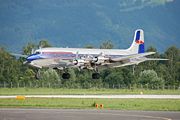Douglas DC-6
| Douglas DC-6 | |
|---|---|
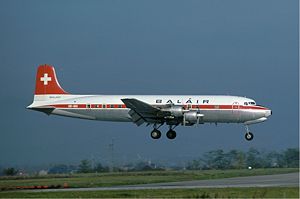 |
|
| Douglas DC-6B of Swiss airline Balair in 1976 | |
| Role | Airliner/transport aircraft |
| Manufacturer | Douglas Aircraft Company |
| First flight | 15 February 1946 |
| Introduced | March 1947 |
| Status | 49 fully active |
| Primary users | United States Air Force United States Navy |
| Produced | 1946-1959 |
| Number built | >700 |
| Developed from | Douglas DC-4 |
| Variants | Douglas DC-7 |
The Douglas DC-6 is a piston-powered airliner and transport aircraft built by the Douglas Aircraft Company from 1946 to 1959. Originally intended as a military transport near the end of World War II, it was reworked after the war to compete with the Lockheed Constellation in the long-range transport market. More than 700 were built, and many still fly today in cargo, military, and wildfire control roles.
The DC-6 was known as the C-118 Liftmaster in United States Air Force service, and as the R6D in United States Navy service.
Contents |
Design and development
The United States Army Air Forces commissioned the DC-6 project as the XC-112 in 1944. The Air Force wanted an expanded, pressurized version of the popular C-54 Skymaster transport with improved engines. By the time the XC-112 flew, the war was over, and the USAAF had rescinded its requirement.
Douglas converted its prototype into a civil transport (redesignated YC-112A, having significant differences from subsequent production DC-6 aircraft) and delivered the first production DC-6 in March 1947. However, a series of mysterious in-flight fires (including the fatal crash of United Airlines Flight 608) grounded the DC-6 fleet later that year. The cause was found to be a fuel vent located adjacent to the cabin cooling turbine intake. All DC-6s in service were modified to correct the problem, and the fleet was flying again after just four months on the ground.
Operational history

Pan Am used DC-6B aircraft to inaugurate its first trans-Atlantic tourist class flights, starting in 1952.
Douglas designed four basic variants of the DC-6: the "basic DC-6," and the longer fuselage, higher-gross-weight, longer range versions—the "DC-6A" with large cargo doors forward and aft of the wing on the port (left hand side) with a cargo floor, the "DC-6B" designed for passenger work,had passengers doors only and a lighter floor and the "DC-6C" a "convertible" aircraft built with the 2 cargo doors, but fitted with removable passenger seats. The military version, essentially similar to the DC-6A, was the USAF C-118 Liftmaster, and the USN R6D. The DC-6B, powered by Pratt & Whitney R-2800-CB-17 engines with Hamilton Standard 43E60 constant speed reversing propellers, was regarded as the ultimate piston-engine airliner from the standpoint of ruggedness, reliability, economical operation and handling qualities.
The USAF and USN renewed their interest in the DC-6 during the Korean War, and ordered a total of 167 C-118/R6D aircraft, some of which later found their way into civilian service. Harry Truman's first presidential aircraft was an Air Force VC-118 called The Independence.
Total production of the DC-6 Series was 702 including military versions.
In the 1960s, two DC-6s were used as transmitter platforms for educational television, based at Purdue University, in a program called MPATI (Midwest Program for Airborne Television Instruction).[1]
Many older DC-6 aircraft were replaced in airline passenger service by the Douglas DC-7, but the simpler, more economic engines in the DC-6 has meant that this type has out-lived the more sophisticated DC-7. DC-6/7s surviving into the Jet Age were replaced in front line service by Boeing 707 and Douglas DC-8 aircraft.
2006 marked the 60th anniversary since the introduction of the DC-6.
Variants
- XC-112
- United States military designation of an improved version of the C-54 (DC-4); became the prototype DC-6. Eventually designated YC-112A, pressurized, P&W R-2800-83AM3 engines
- DC-6
- Main production variant
- DC-6A
- Fitted with cargo door.
- DC-6B
- Passenger only variant.
- DC-6C
- Convertible cargo/passenger variant.
- VC-118
- One DC-6 bought as a presidential transport with special 25 seat interior and 12 beds.
- C-118A
- Designation of DC-6As for the United States Air Force, 101 built.
- VC-118A
- C-118As converted as staff transports.
- C-118B
- R6D-1s re-designated.
- VC-118B
- R6D-1Zs re-designated.
- R6D-1
- United States Navy designation for the DC-6A, 65 built.
- R6D-1Z
- Four R6D-1s converted as staff transports.
Operators

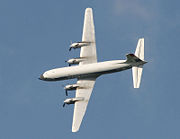
- Current operators of the DC-6
- Today, most DC-6s in commercial use are based in Alaska. Several other DC-6s are still in operation for small carriers in South America.
- About 100 DC-6s still fly (or are potentially capable of flight).
- In 2002, 49 were fully active.
- One DC-6A, G-APSA, is in use by Air Atlantique, Coventry, UK. They also own a DC-6B, G-SIXC.[2]
- One is in use by Red Bull in Salzburg, Austria.
- One DC-6 is in use by Namibia Commercial Aviation.
- An unknown number are in use as freighters or waterbombers in Canada and the western US.
Civil operators
 New Zealand
New Zealand
- TEAL
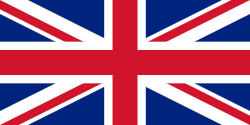 United Kingdom
United Kingdom
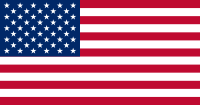 United States
United States
- Air Cargo Express
- Everts Air Fuel
- Northern Air Cargo
Military operators
 Argentina
Argentina Belgium
Belgium Bolivia
Bolivia Brazil
Brazil Chile
Chile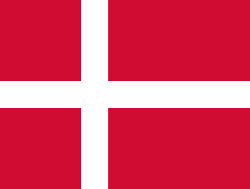 Denmark
Denmark Republic of China
Republic of China Colombia
Colombia Ecuador
Ecuador El Salvador
El Salvador France
France Germany
Germany Guatemala
Guatemala Honduras
Honduras Italy
Italy South Korea
South Korea Mexico
Mexico New Zealand
New Zealand Paraguay
Paraguay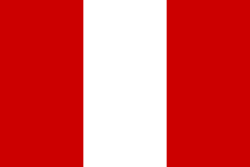 Peru
Peru Portugal
Portugal Republic of China
Republic of China United States
United States South Vietnam
South Vietnam Yugoslavia
Yugoslavia Zambia
Zambia
Notable incidents and accidents
- On 29 November 1949, American Airlines Flight 157 crashed while attempting a 3 engine landing in Dallas Texas, killing 28 people.
- On 12 February 1955, a Sabena DC-6 crashed on mount Terminillo, near Rieti, Italy; 29 people died, including 1953 Miss Italia winner Marcella Mariani.
- On 1 November 1955, a time bomb exploded aboard United Airlines Flight 629, a DC-6, killing 44 people above Longmont, Colorado, USA.
Survivors
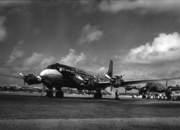
Several DC-6s are preserved in museums.
- The most well-known is President Harry S. Truman's VC-118B Independence (s/n 46-505), which is preserved at the National Museum of the United States Air Force, Wright-Patterson Air Force Base in Dayton, Ohio. It was retired to the Museum in 1965.[3] In 1977-1978 museum personnel restored "Independence" to its former presidential markings and eagle-like paint scheme. The aircraft is on display in the Museum's Presidential Hanger.
Specifications (DC-6B)
Data from Airliners.net[4]
General characteristics
- Crew: 3: captain, copilot, flight engineer, plus attendants appropriate to number of passengers
- Capacity: 54-102 passengers
- Length: 105 ft 7 in (32.18 m)
- Wingspan: 117 ft 6 in (35.81 m)
- Height: 28 ft 5 in (8.66 m)
- Wing area: 1,463 ft (135.9 m)
- Empty weight: 55,357 lb (25,110 kg)
- Max takeoff weight: 107,000 lb (48,500 kg)
- Powerplant: 4× Pratt & Whitney R-2800 CB17 "Double Wasp" radial engine, 2,500 hp (1,700 kW) with water injection each
- Propellers: Hamilton Standard 43E60 "Hydromatic" constant speed props with autofeather and reverse thrust
Performance
- Cruise speed: 274 knots (315 mph, 507 km/h)
- Range: 2,610 nm (3,010 mi, 4,840 km)
- Service ceiling 25,000 ft (7,600 m)
- Rate of climb: 1,070 ft/min (5.44 m/s)
See also
Related development
- Douglas DC-4
- Douglas DC-7
Comparable aircraft
- Lockheed Constellation
- Boeing 377
Related lists
- List of military aircraft of the United States
- List of military aircraft of the United States (naval)
References
Notes
- ↑ Purdue University
- ↑ The Six
- ↑ United States Air Force Museum 1975, p. 43.
- ↑ The Douglas DC-6 Retrieved: 20 March 2006.
Bibliography
- Pearcy, Arthur. Douglas Propliners: DC-1–DC-7. Shrewsbury, UK: Airlife Publishing, 1995. ISBN 1-85310-261-X.
- United States Air Force Museum. Wright-Patterson AFB, Ohio: Air Force Museum Foundation. 1975.
- Whittle, John A. The Douglas DC-6 and DC-7 Series. Tonbridge, Kent, UK: Air Britain (Historians) Ltd., 1971. No ISBN.
- Yenne, Bill. McDonnell Douglas: A Tale of Two Giants. Greenwich, Connecticut: Bison Books, 1985. ISBN 0-517-44287-6.
External links
|
|||||||||||
|
|||||
|
|||||
|
|||||
|
||||||||||||||
